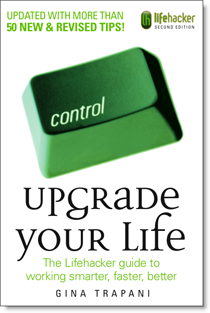
That’s the philosophy of her site Lifehacker (which is a totally awesome site, if you’ve never checked it out, you definitely should!), which looks at workarounds and shortcuts that use technology but concentrates on how it can improve your daily life. It’s also at the heart of her spin-off book, the first edition of which I recently came across. As I’ll explore later, this has now been replaced by a second edition, renamed Upgrade Your Life, which appears to have fixed some issues with the original.
The key to the book is the idea that a “Lifehacker” is somebody who would happily spend 2 hours 59 minutes to automate a process which takes 3 hours to complete. It’s based around 88 “hacks” (130+ in the second edition), as diverse as automated back-ups, carrying portable editions of multiple applications and operating systems on a single USB drive, and taking more efficient handwritten notes.
Partly because the edition I read is dated, and partly because it flits between general principles and fairly complex technical operations, I found certain sections more useful than others. Despite the detail, it was the overall guides to e-mail and organization which I found most productive.
For example, I hadn’t realized that Google Calendar can be set to send an e-mail 20 minutes before a scheduled event, adding extra handy to-do functionality. This proved particularly useful as with one of my writing clients, I produce the work throughout the week and then e-mail it on Fridays as a complete batch, a task I sometimes forget if I’ve got a busy workload. I’ve now set up a recurring weekly event on the calendar which now e-mails me an alert at a time I know I’ll be sat at my computer writing.
The chapter on controlling e-mail is free to download from the book’s official site, which is a good marketing ploy as it’s arguably the best chapter, and the one with the widest appeal. There’s some good advice which I wouldn’t necessary guarantee I’ll follow such as cutting down the frequency your mail client checks for messages and becoming comfortable with not feeling the need to reply to non-urgent messages instantly (which only encourages senders to expect an instant response everytime).
The one “hack” I’ve adopted most closely is the three folder/empty inbox approach. Taken from a posting on the Lifehacker site, it’s a strategy that says you should aim to empty your inbox every time you visit it rather than let things mount up, acting on anything that will take less than a minute to do so, and deleting anything you are certain you’ll never need to read again. Everything else goes into one of three folders: Action (for messages which need you to do something), Hold (for messages you know you’ll refer to in the near future) and Archive (for everything else).
Having tried this, it’s amazing how much of a psychological benefit it is to not have hundreds of messages building up, and to be able to see at a glance what actions I need to take to be “up to date” with dealing with my e-mail.
The biggest negative of the original edition is that although it is organized by loose topic, it would have worked better to pay some attention to the comparative complexity of the various tips and reflect this in the ordering, both of the chapters and within the chapters.
For example, the very second hack in the book is to use Notepad for a to do list, but to control it via the command line. While some readers won’t be fazed by instructions to “configure the todo.ch script” in a process where commands are “executed at the Cygwin prompt”, it’s going to alienate many potential readers.
Yet later in the book, there’s advice to run a firewall and a virus checker, and to keep an eye on which program runs at startup: all of which will likely be second nature to anyone who’d bother to read such a book. I should note that the second edition has reorganized the chapter list significantly, so it may well also have fixed this problem.
Despite being only four years ago, much of the information is very noticeably dated. That doesn’t mean it is inaccurate, merely that many arguably superior alternatives are now available to some of the tracks.
With the second edition released in 2008, those considering buying the book might want to wait to see if there’s a third edition: simply updating the piece to include Windows 7 and Google Chrome would go a long way to overcoming the dating problems.
In the meantime, I’d be hesitant to say the book is worth a full-price purchase, mainly because the wide disparity of sophistication and complexity of the different tips means its unlikely most readers will benefit from more than a portion of it. However, if you can beg, borrow (but obviously not steal) a copy, it’s well worth a flick through.
